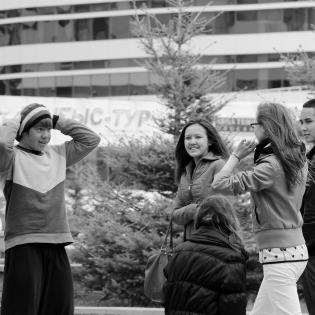Recognizing Bias
Learners recognize that we all have biases, but we aren't always aware of them, which can create an unfair situation. Since people have different experiences, we all develop different biases.
The learner will:
- define bias.
- reflect in writing about a personal bias and make a plan for overcoming the bias when making decisions or judgments.
Instructions
Anticipatory Set
Play a game called "Find the Common Trait." In this game, the participants mingle around the room slowly, until the leader says a number between 2 and 5. Upon hearing the number, the participants quickly join into groups of the named number. In that group, they need to talk among themselves until they find something they all have in common. It may be something physical such as eye color or type of shoes, or it may be something related to an interest, a practice, or their family. When they find a commonality, they raise their hand and tell the whole group. After hearing from all the groups, they mingle again.
The leader names a new number between 2-5 and they group up again. In the new group, they look for a common trait again.
After playing two or three times, debrief about the activity. Ask how difficult it is to find something that they have in common. Ask how finding things in common between diverse people might help them in a conflict.
Each person's experiences and personalities form who they are, how they act, and what they believe. We see the world through the lens of our unique experiences. Introduce the word bias. [A bias is a point of view influenced by experience.]
We all have biases, but we aren't always aware of them. Since people have different experiences, we all develop different biases. Read the following story that shows how a bias can create an unfair situation.
When a big-city symphony wants to hire musicians, they do not judge the applicants on their appearance; they judge them only on their musical ability. That seems fair, doesn't it? But that hasn't always been the case. At one time, more men than women were hired to play in symphonies. For some reason, the judges preferred certain genders, races, and other factors unrelated to musical talent. Today, however, most symphonies listen to the musician applicants from behind a screen so they can't see what they look like. Sometimes the musicians even have to take off their shoes so the judges can't get hints from their footsteps about whether they are listening to a man or woman. Although that may seem unnecessary, it has been proven to be the fairest way to hire. Now, because of the practice of "blind auditions," the diversity makeup is more balanced. This is how the symphony overcame a bias. It wasn't enough just to be aware they had a bias; they had to guarantee it with a "blind audition" so they wouldn't let their bias toward male musicians influence their decisions.
Discuss why blind auditions are a fair way to hire musicians.
The learners write in their journals about a personal bias that may not be fair to others. For example, they may form unfair opinions of people based on their looks, interests, dialect, clothing, neighborhood, or what music they listen to. Tell them to write about why they think they have the bias and what they can do to make sure they don't treat others unfairly because of their bias. This does not need to be shared.
Philanthropy Framework
-
Strand PHIL.I Definitions of Philanthropy
-
Standard DP 01. Define Philanthropy
-
Benchmark MS.4 Give examples of how individuals have helped others.
-
-
Standard DP 02. Roles of Government, Business, and Philanthropy
-
Benchmark MS.1 Describe how different needs are met in different ways by government, business, civil society, and family.
-
-
-
Strand PHIL.III Philanthropy and the Individual
-
Standard PI 01. Reasons for Individual Philanthropy
-
Benchmark MS.9 Identify pro-social behavior in different cultures and traditions.
-
-
